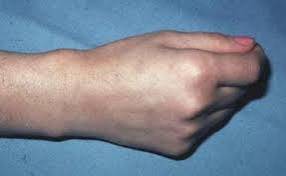De Quervain's Tenosynovitis
De Quervain’s tenosynovitis is a painful condition that affects the tendons on the thumb side of the wrist. It occurs when the tendons around the base of the thumb become irritated or constricted, causing pain, tenderness, and swelling. This condition is common in people who perform repetitive hand or wrist movements.
---
20 Causes of De Quervain's Tenosynovitis
1. Repetitive Hand Movements: Frequent wrist or thumb motion, such as typing or texting, can strain the tendons.
2. Overuse of the Thumb: Excessive use of the thumb during activities like gaming or crafting.
3. Lifting Infants: New parents often experience this condition due to repetitive lifting of babies.
4. Hormonal Changes: Pregnancy and breastfeeding can increase the risk due to hormonal changes.
5. Trauma to the Wrist: Direct injury or trauma to the wrist or thumb can lead to inflammation.
6. Rheumatoid Arthritis: People with rheumatoid arthritis are more prone to developing tenosynovitis.
7. Age: Common in people aged 30-50, especially women.
8. Gender: Women are more likely to develop this condition than men.
9. Sports Activities: Repetitive sports like tennis, golf, or rowing can strain the wrist tendons.
10. Typing: Continuous typing on a keyboard or using a computer mouse can contribute.
11. Knitting and Sewing: Frequent handwork with needles can lead to overuse of the thumb.
12. Manual Labor: Jobs involving repetitive hand and wrist movements, like construction, can cause strain.
13. Inflammatory Conditions: Conditions like lupus or psoriasis can increase inflammation in tendons.
14. Dehydration: Lack of fluid can reduce tendon elasticity, leading to irritation.
15. Cold Temperatures: Working in cold conditions can make tendons stiffer and more prone to injury.
16. Hand-Held Devices: Prolonged use of smartphones or tablets with repetitive thumb movements.
17. Poor Ergonomics: Poor posture or hand positioning during work or activities.
18. Tendon Scarring: Previous injuries to the tendon can lead to scarring and inflammation.
19. Excessive Texting: Repeated texting or scrolling on smartphones can aggravate the thumb tendons.
20. Carrying Heavy Objects: Lifting or carrying heavy objects with poor wrist positioning.
---
20 Signs and Symptoms of De Quervain's Tenosynovitis
1. Pain on the Thumb Side of the Wrist: Sharp or dull pain near the base of the thumb.
2. Swelling Near the Base of the Thumb: Visible or palpable swelling in the affected area.
3. Difficulty Moving the Thumb: Limited motion or stiffness, particularly when gripping objects.
4. Tenderness: Sensitivity to touch along the thumb and wrist tendons.
5. Radiating Pain: Pain that travels up the forearm when using the hand or thumb.
6. Thumb Weakness: Weakness in the thumb when trying to lift objects or pinch.
7. Pain with Wrist Movements: Discomfort when rotating the wrist or gripping items.
8. Snapping Sensation: A feeling of snapping or catching when moving the thumb.
9. Difficulty Grasping: Trouble gripping or holding items, particularly small objects.
10. Stiffness in the Wrist: Generalized stiffness in the affected wrist, especially after periods of inactivity.
11. Burning Sensation: A burning feeling in the thumb or wrist area.
12. Pain During Pinching: Pain when pinching or squeezing objects with the thumb.
13. Pain with Thumb Movement: Increased discomfort when moving the thumb away from the hand.
14. Tender Lump: A small bump may form near the base of the thumb.
15. Redness: Mild redness in the area due to inflammation.
16. Warmth Around the Thumb: The affected area may feel warm due to swelling and irritation.
17. Pain when Lifting Objects: Discomfort or pain when lifting heavier items.
18. Loss of Thumb Dexterity: Reduced ability to perform fine motor tasks.
19. Increased Pain with Repetition: Pain worsens after repetitive hand or thumb activities.
20. Pain with Wrist Extension: Moving the wrist backward increases discomfort.
---
10 Effects of De Quervain's Tenosynovitis
1. Chronic Pain: Persistent pain in the wrist and thumb area.
2. Loss of Hand Function: Difficulty performing daily tasks like writing, lifting, or gripping objects.
3. Reduced Thumb Mobility: Limited ability to move the thumb fully, affecting hand dexterity.
4. Weak Grip Strength: Weakened ability to hold onto or grip objects firmly.
5. Wrist Stiffness: Prolonged stiffness and discomfort in the wrist joint.
6. Interference with Work: Difficulty performing tasks that involve hand and wrist movement.
7. Inflammation Spreading: Untreated inflammation can spread to nearby tendons and muscles.
8. Chronic Swelling: Persistent swelling at the base of the thumb.
9. Dependence on Pain Relievers: Long-term use of medications to manage pain and inflammation.
10. Surgical Intervention: Severe cases may require surgery to relieve tendon pressure.
---
Prevention of De Quervain's Tenosynovitis
1. Take Breaks: Avoid repetitive hand and thumb motions by taking regular breaks during activities.
2. Ergonomic Tools: Use ergonomic keyboards, mouse pads, and tools to reduce strain on the thumb and wrist.
3. Strengthening Exercises: Perform hand and wrist exercises to strengthen the tendons and improve flexibility.
4. Maintain Good Posture: Proper hand positioning during activities can reduce strain on the wrist.
5. Stretch Regularly: Stretching the thumb and wrist tendons can help prevent stiffness and injury.
6. Use Thumb Supports: Wearing a brace or splint during repetitive activities can help limit motion and protect the thumb.
7. Avoid Overuse: Minimize activities that involve repetitive or forceful use of the wrist and thumb.
8. Modify Daily Habits: Adjust daily tasks to reduce pressure on the thumb, such as switching hands when lifting.
9. Reduce Screen Time: Limit smartphone and device use to prevent excessive thumb movements.
10. Treat Injuries Promptly: Address any wrist or thumb injuries early to prevent chronic inflammation.
By taking preventative measures and modifying activities, the risk of developing De Quervain's tenosynovitis can be minimized, and early symptoms can be managed to avoid long-term complications.


